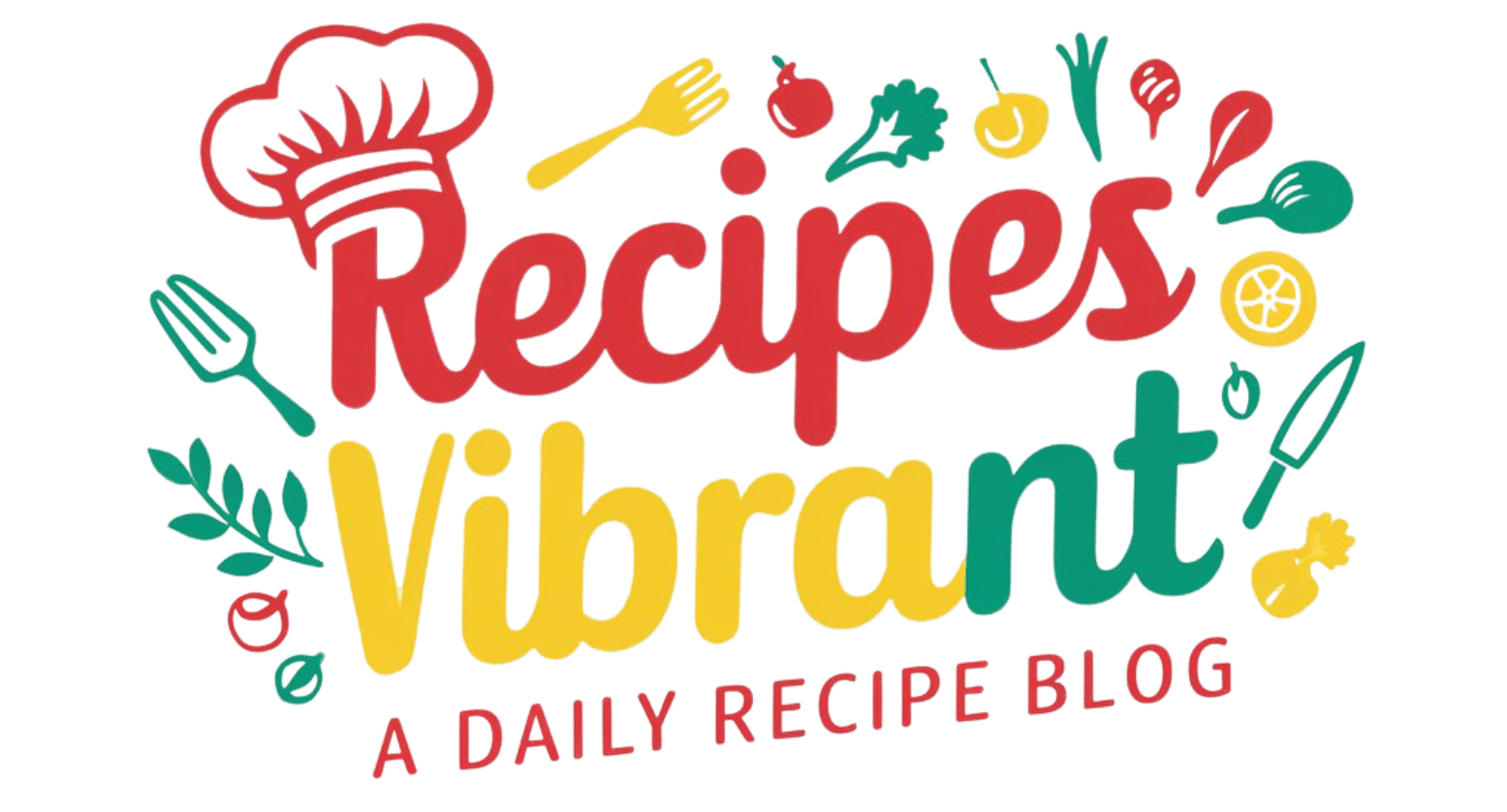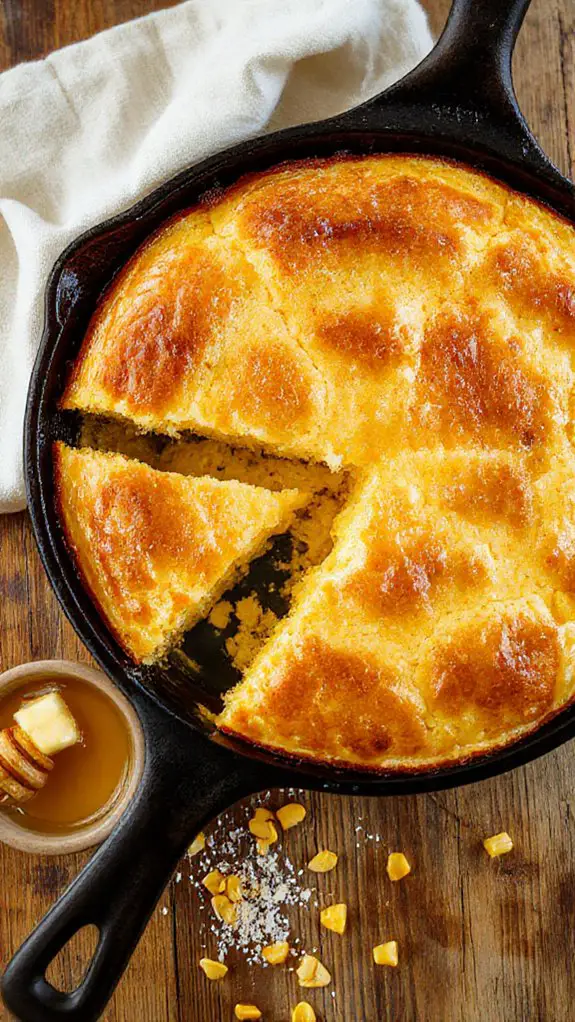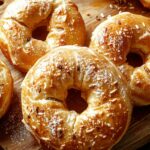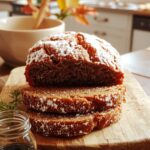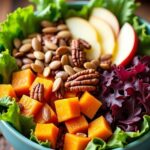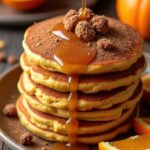I’ve spent years perfecting my cornbread recipe, and I can tell you there’s nothing quite like the aroma of golden cornbread baking in a cast iron skillet. The secret isn’t just in the ingredients—though they matter—it’s in understanding how heat, timing, and technique work together. Most people make one vital mistake that turns what should be moist, tender cornbread into something dry and crumbly.
Cornbread Recipe
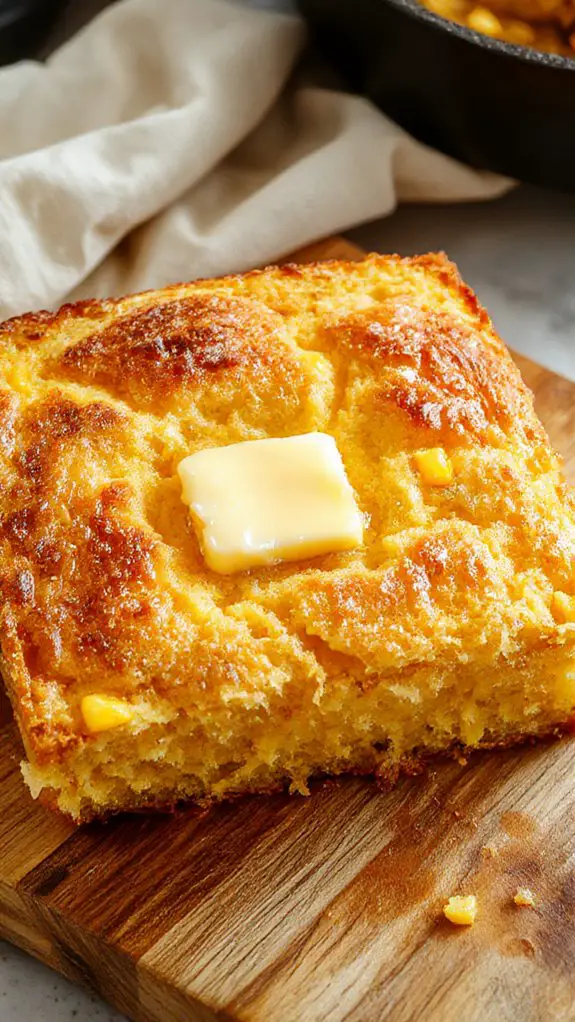
I can promise you with absolute confidence that this is the cornbread recipe that will change everything you thought you knew about this Southern staple.
After perfecting this recipe through countless batches and tweaking every little detail, I’ve landed on something truly magical—a cornbread that strikes the perfect balance between tender crumb and satisfying texture, with a golden crust that practically sings when you tap it.
What makes this version so incredibly special is the combination of both cornmeal and a touch of real corn kernels for extra sweetness, plus a secret splash of buttermilk that creates the most amazing tang and keeps every bite impossibly moist.
My grandmother always said that good cornbread should be sturdy enough to hold up to a bowl of chili but tender enough to melt in your mouth with just a pat of butter, and this recipe delivers exactly that.
When you pull this beauty from the oven, you’ll be greeted by the most intoxicating aroma of toasted corn and that signature golden-brown top that’s slightly crispy on the outside but gives way to a fluffy, almost cake-like interior that’s dotted with those bursts of sweet corn flavor.
Whether you’re a cornbread purist or someone who’s been disappointed by dry, crumbly versions in the past, this foolproof recipe will have you serving up squares that disappear faster than you can cut them—and trust me, you’ll find yourself making this on repeat because once you taste homemade cornbread this good, there’s simply no going back to anything else.
Ingredients
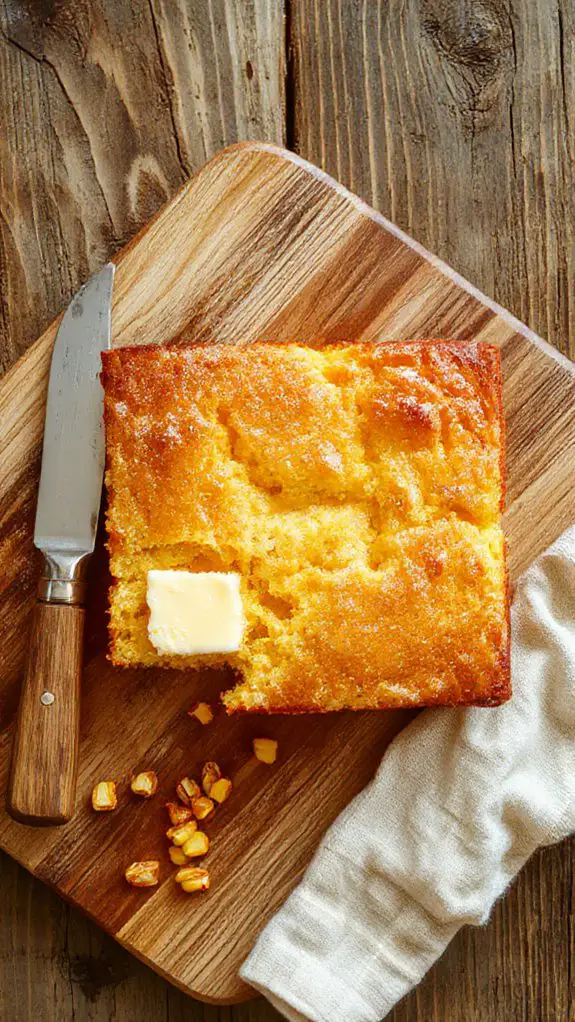
Perfect cornbread starts with getting your ingredients right—and trust me, the good stuff makes all the difference. Use medium or coarse cornmeal instead of fine for that authentic, slightly gritty texture that separates real cornbread from cake masquerading as cornbread. And here’s a game-changer: let your batter rest for 10 minutes after mixing so the cornmeal can hydrate properly for the most tender crumb.
Vital Dry Ingredients:
- 1 cup yellow cornmeal (medium grind is non-negotiable—it creates the perfect texture)
- 1 cup all-purpose flour (don’t go gluten-free here unless you must; regular flour gives the best rise)
- 1/4 cup granulated sugar (just enough sweetness to balance the corn—Southerners, feel free to cut this in half)
- 1 tablespoon baking powder (fresh is vital; if it doesn’t foam when you add water, toss it)
- 1 teaspoon salt (kosher salt works best for even distribution)
Wet Ingredients That Make Magic:
- 1 cup buttermilk (the tang is everything—no buttermilk? Add 1 tablespoon vinegar to regular milk and wait 5 minutes)
- 2 large eggs (room temperature eggs mix easier and create a smoother batter)
- 1/3 cup melted butter (or bacon fat if you want to be a hero—vegetable oil works too but lacks flavor)
The Secret Weapon:
• 2 tablespoons additional butter or oil (for greasing your cast iron skillet—this creates that coveted crispy crust that makes people think you’re a cornbread wizard)
How to Make the Best Sweet Southern Skillet Cornbread
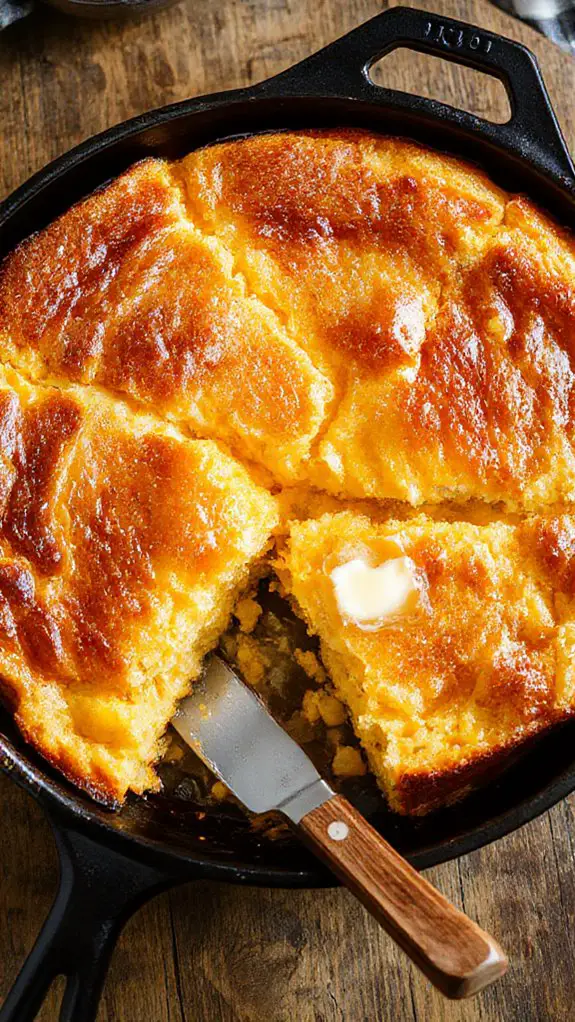
- Preheat your oven to 425°F and place your 10-inch cast iron skillet inside to heat up.
This high temperature creates that signature crispy crust Southern cornbread is famous for. Starting with a hot skillet is essential—cold metal won’t give you the golden, crunchy bottom that makes this recipe special.
If you don’t have cast iron, a 9-inch round cake pan works, but you’ll miss out on some of that magical crust.
- In a large bowl, whisk together 1 cup yellow cornmeal, 1 cup all-purpose flour, ¼ cup granulated sugar, 1 tablespoon baking powder, and 1 teaspoon salt.
The combination of cornmeal and flour gives you the perfect texture—not too heavy, not too crumbly. Yellow cornmeal provides better flavor than white, and that touch of sugar balances the corn’s natural earthiness without making it dessert-sweet.
Make sure your baking powder is fresh (less than 6 months old) for maximum lift.
- In a separate bowl, beat together 1 cup buttermilk, 2 large eggs, and ⅓ cup melted butter until well combined.
Room temperature eggs mix more easily and create a smoother batter. If your eggs are cold, place them in warm water for 5 minutes before cracking.
The buttermilk’s acidity reacts with the baking powder for extra tenderness, and if you don’t have any, stir 1 tablespoon white vinegar into regular milk and let it sit for 5 minutes.
- Pour the wet ingredients into the dry ingredients and stir just until combined—don’t overmix.
You’ll see lumps, and that’s exactly what you want. Overmixing develops the gluten in flour, turning your tender cornbread into a tough, dense brick.
Stop stirring the moment you can’t see any dry flour patches. The batter should look rough and barely combined.
- Carefully remove the hot skillet from the oven using oven mitts and add 2 tablespoons of butter, swirling to coat the bottom and sides.
The butter should sizzle immediately when it hits the hot pan—this sound tells you you’re on the right track.
Tilt the skillet to spread the butter evenly up the sides, which prevents sticking and creates an extra layer of golden crust. Work quickly so the skillet stays hot.
- Pour the batter into the sizzling skillet—it should bubble and pop around the edges.
This dramatic sizzling is music to your ears and means you’ll get that coveted crispy bottom crust.
Pour from a low height to avoid splashing hot butter, and don’t worry about spreading the batter—it will level itself as it bakes. The edges should start setting almost immediately.
- Bake for 20-25 minutes until the top is golden brown and a toothpick inserted in the center comes out with just a few moist crumbs.
Start checking at 20 minutes since oven temperatures vary. The cornbread should spring back lightly when touched in the center, and the edges will pull slightly away from the sides.
A few moist crumbs on your toothpick are perfect—completely clean means you’ve overbaked it.
- Let cool in the skillet for 10 minutes before cutting and serving.
This cooling time lets the cornbread finish cooking from residual heat and makes cutting much cleaner.
Serve it warm with butter and honey for the full Southern experience. Leftover cornbread keeps covered for 2 days and makes incredible cornbread stuffing or croutons.
Chef Tips
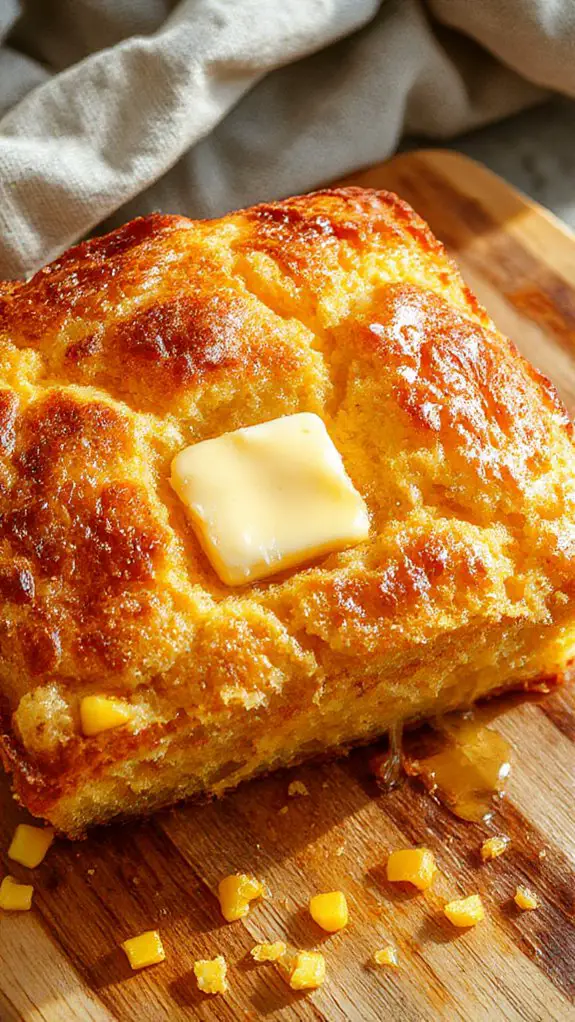
While mastering cornbread seems straightforward, a few professional tricks will elevate your results from good to exceptional.
I always preheat my cast iron skillet with oil to create that coveted crispy crust.
For different cornbread variations, I adjust sugar levels and experiment with add-ins. These baking techniques guarantee consistent texture and perfect golden color every time.
Nutrition
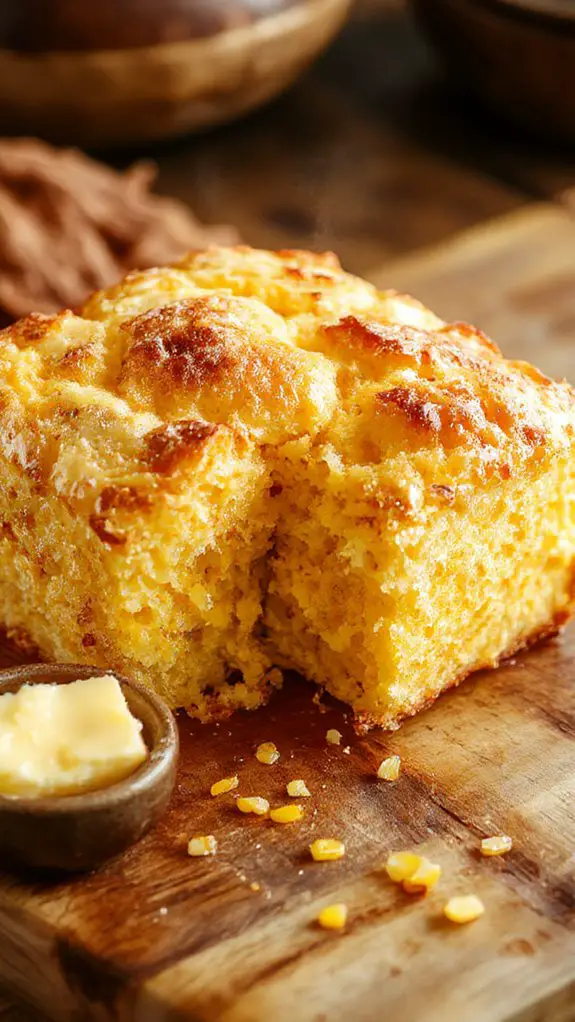
Cornbread is a good source of carbohydrates and provides moderate amounts of protein and fat. The nutritional content can vary depending on the specific recipe and ingredients used.
| Nutrient | Amount per serving (1 piece, ~60g) |
|---|---|
| Calories | 198 |
| Total Fat | 6.8g |
| Saturated Fat | 1.8g |
| Cholesterol | 37mg |
| Sodium | 467mg |
| Total Carbohydrates | 30.8g |
| Dietary Fiber | 1.4g |
| Sugars | 5.9g |
| Protein | 4.7g |
| Calcium | 141mg |
| Iron | 1.6mg |
| Potassium | 77mg |
| Vitamin A | 108 IU |
What You’ll Love About This Cornbread Recipe
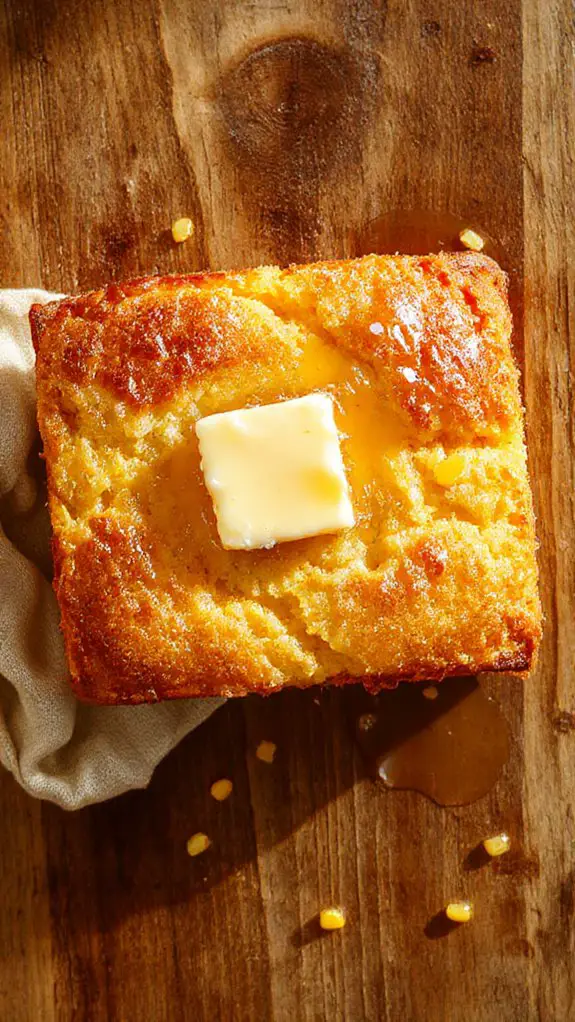
This cornbread recipe brings together everything you want in a classic comfort food, with a perfect balance of sweet and savory that makes every bite satisfying.
Whether you’re serving it alongside a hearty chili or enjoying it warm with butter and honey, this cornbread delivers the kind of homestyle goodness that brings families together around the dinner table.
- Quick and simple preparation – With just basic pantry ingredients and one bowl, you can have fresh cornbread ready in under an hour, making it perfect for busy weeknights or last-minute dinner additions.
- Perfect texture every time – This recipe creates cornbread with a tender, moist crumb and a slightly crispy golden crust that holds up beautifully whether you’re crumbling it into soup or eating it on its own.
- Versatile and customizable – You can easily adjust the sweetness level, add mix-ins like jalapeños or cheese, or bake it in a cast iron skillet for that authentic Southern touch that makes every meal feel special.
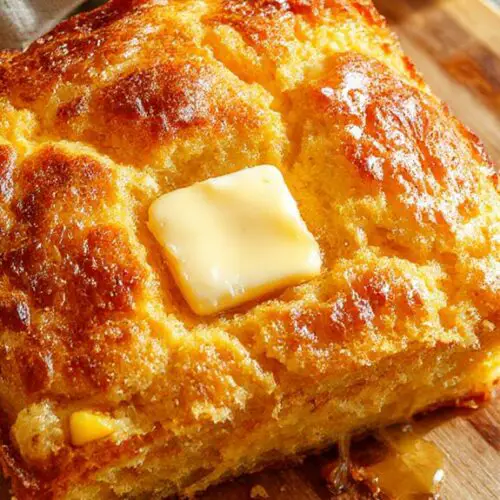
Cornbread Recipe
Equipment
- 10-inch cast iron skillet
- Large mixing bowls
- Whisk
- Measuring cups and Spoons
Ingredients
- 1 cup yellow cornmeal
- 1 cup all-purpose flour
- 1/4 cup granulated sugar
- 1 tablespoon baking powder
- 1 teaspoon salt
- 1 cup buttermilk
- 2 large eggs
- 1/3 cup vegetable oil
- 3 tablespoons butter
Instructions
- Preheat oven to 425°F (220°C). Place a 10-inch cast iron skillet in the oven while preheating.
- In a large bowl, whisk together cornmeal, flour, sugar, baking powder, and salt.
- In a separate bowl, combine buttermilk, eggs, and vegetable oil.
- Pour wet ingredients into dry ingredients and stir until just combined. Don’t overmix.
- Carefully remove hot skillet from oven and add butter, swirling to coat.
- Pour batter into the sizzling skillet.
- Bake for 20-25 minutes until golden brown and a toothpick inserted in center comes out clean.
- Cool for 5 minutes before slicing and serving.
Notes
- For sweeter cornbread, increase sugar to 1/2 cup
- Substitute regular milk for buttermilk if needed, but reduce baking powder to 2 teaspoons
- Can be baked in a greased 9×9 inch baking pan instead of cast iron skillet
Frequently Asked Questions
What Is the History and Origin of Cornbread?
I’ll trace how Native Americans first developed this bread using corn, then European settlers adapted cornbread ingredients like cornmeal and milk, creating regional variations that became deeply embedded in Southern cornbread culture and American cuisine traditions.
Can Cornbread Be Frozen and How Long Does It Last?
I’ll share freezing techniques that work perfectly for this baked good. You can freeze it for up to three months. For thawing methods, I recommend room temperature defrosting or gentle oven reheating to restore texture.
What Are Regional Variations of Cornbread Across Different States?
I’ve noticed fascinating regional differences across America. Southern Style tends toward sweet, cake-like textures, while Northern Style stays savory and dense. Tex Mex Twist adds jalapeños and cheese, and Vegan Variations substitute plant-based ingredients.
Why Do Some Cornbread Recipes Include Sugar While Others Don’t?
I’ll explain why recipes differ – it’s about sweet versus savory preferences and texture preferences. Northern cooks often add sugar for cake-like sweetness, while Southern tradition keeps it savory and dense without any sweeteners added.
What’s the Difference Between Cornbread and Corn Muffins?
I’ve noticed the main differences lie in cornbread texture being more dense and crumbly, while corn muffins tend toward muffin sweetness with a lighter, cake-like consistency that’s typically sweeter overall.
